Computational Study of Structural, Molecular Orbitals, Optical and Thermodynamic Parameters of Thiophene Sulfonamide Derivatives
Abstract
1. Introduction
2. Computational Details
3. Results and Discussion
3.1. Geometrical Parameters
3.2. Frontier Molecular Orbital Analysis
3.3. Nonlinear Optical (NLO) Properties
3.4. Molecular Electrostatic Potential (MESP)
3.5. IR Spectra
3.6. UV-Vis Spectrum
3.7. Conceptual DFT Reactivity Descriptors
4. Conclusions
Supplementary Materials
Author Contributions
Funding
Institutional Review Board Statement
Informed Consent Statement
Data Availability Statement
Acknowledgments
Conflicts of Interest
References
- Xiao-Hong, L.; Xiang-Ru, L.; Xian-Zhou, Z. Calculation of vibrational spectroscopic and NMR parameters of 2-dicyanovinyl-5-(4-N, N-dimethylaminophenyl) thiophene by ab initio HF and density functional methods. Comput. Chem. 2011, 969, 27–34. [Google Scholar] [CrossRef]
- Chen, Y.; Wan, X.; Long, G. High performance photovoltaic applications using solution-processed small molecules. Acc. Chem. Res. 2013, 46, 2645–2655. [Google Scholar] [CrossRef] [PubMed]
- Li, L.; Zhao, C.; Wang, H. Recent Progress in Synthesis and Application of Thiophene Oligomers Based on Bithiophene Dicarbanions. Chem. Rec. 2016, 16, 797–809. [Google Scholar] [CrossRef] [PubMed]
- Qin, H.; Wenger, S.; Xu, M.; Gao, F.; Jing, X.; Wang, P.; Zakeeruddin, S.M.; Grätzel, M. An Organic Sensitizer with a Fused Dithienothiophene Unit for Efficient and Stable Dye-Sensitized Solar Cells. J. Am. Chem. Soc. 2008, 130, 9202–9203. [Google Scholar] [CrossRef]
- Chao, J.; Wang, X.; Liu, Y.; Zhang, Y.; Huo, F.; Yin, C.; Zhao, M.; Sun, J.; Xu, M. A pyrene-thiophene based fluorescent probe for ratiometric sensing of bisulfite and its application in vivo imaging. Sens. Actuator B Chem. 2018, 272, 195–202. [Google Scholar] [CrossRef]
- Sial, N.; Rasool, N.; Rizwan, K.; Altaf, A.A.; Ali, S.; Malik, A.; Zubair, M.; Akhtar, A.; Kausar, S.; Shah, S.A.A. Efficient synthesis of 2, 3-diarylbenzo [b] thiophene molecules through palladium (0) Suzuki–Miyaura cross-coupling reaction and their antithrombolyitc, biofilm inhibition, hemolytic potential and molecular docking studies. Med. Chem. Res. 2020, 29, 1486–1496. [Google Scholar] [CrossRef]
- Wan, Y.; Wallinder, C.; Plouffe, B.; Beaudry, H.; Mahalingam, A.; Wu, X.; Johansson, B.; Holm, M.; Botoros, M.; Karlén, A. Design, synthesis, and biological evaluation of the first selective nonpeptide AT2 receptor agonist. J. Med. Chem. 2004, 47, 5995–6008. [Google Scholar] [CrossRef]
- Do, C.V.; Faouzi, A.; Barette, C.; Farce, A.; Fauvarque, M.-O.; Colomb, E.; Catry, L.; Berthier-Vergnes, O.; Haftek, M.; Barret, R. Synthesis and biological evaluation of thiophene and benzo [b] thiophene analogs of combretastatin A-4 and isocombretastatin A-4: A comparison between the linkage positions of the 3, 4, 5-trimethoxystyrene unit. Bioorg. Med. Chem. Lett. 2016, 26, 174–180. [Google Scholar] [CrossRef]
- Rizwan, K.; Zubair, M.; Rasool, N.; Mahmood, T.; Ayub, K.; Alitheen, N.B.; Aziz, M.N.M.; Akhtar, M.N.; Bukhary, S.M.; Ahmad, V.U. Palladium (0) catalyzed Suzuki cross-coupling reaction of 2, 5-dibromo-3-methylthiophene: Selectivity, characterization, DFT studies and their biological evaluations. Chem. Cent. J. 2018, 12, 49. [Google Scholar] [CrossRef]
- Nasr, T.; Bondock, S.; Eid, S. Design, synthesis, antimicrobial evaluation and molecular docking studies of some new thiophene, pyrazole and pyridone derivatives bearing sulfisoxazole moiety. Eur. J. Med. Chem. 2014, 84, 491–504. [Google Scholar] [CrossRef]
- Miao, Q.; Yan, X.; Zhao, K. Synthesis, Structure and Anticancer Activity Studies of 1-[(5-Bromo-2-thienyl) sulfonyl]-5-fluoro-1, 2, 3, 4-tetrahydropyrimidine-2, 4-dione. Chin. J. Chem. 2010, 28, 81–85. [Google Scholar] [CrossRef]
- Pulipati, L.; Sridevi, J.P.; Yogeeswari, P.; Sriram, D.; Kantevari, S. Synthesis and antitubercular evaluation of novel dibenzo [b, d] thiophene tethered imidazo [1, 2-a] pyridine-3-carboxamides. Bioorg. Med. Chem. Lett. 2016, 26, 3135–3140. [Google Scholar] [CrossRef]
- Deng, H.; Hu, J.; Hu, H.; He, M.; Fang, Y. Thieno [3, 2-b] thiophene-2-carboxylic acid derivatives as GPR35 agonists. Bioorg. Med. Chem. Lett. 2012, 22, 4148–4152. [Google Scholar] [CrossRef] [PubMed]
- Pandya, D.H.; Sharma, J.A.; Jalani, H.B.; Pandya, A.N.; Sudarsanam, V.; Kachler, S.; Klotz, K.N.; Vasu, K.K. Novel thiazole–thiophene conjugates as adenosine receptor antagonists: Synthesis, biological evaluation and docking studies. Bioorg. Med. Chem. Lett. 2015, 25, 1306–1309. [Google Scholar] [CrossRef] [PubMed]
- Baffoe, J.; Hoe, M.Y.; Toure, B.B. Copper-mediated N-heteroarylation of primary sulfonamides: Synthesis of mono-N-heteroaryl sulfonamides. Org. Lett. 2010, 12, 1532–1535. [Google Scholar] [CrossRef]
- Ali, E.H.; Nassar, F.I.; Badawi, A.; Afify, S.A. Physical properties and biological applications of novel substituted biphenyl-sulfonamides. Int. J. Genet. Mol. Biol. 2010, 2, 78–91. [Google Scholar]
- Perlovich, G.L.; Strakhova, N.N.; Kazachenko, V.P.; Volkova, T.V.; Tkachev, V.V.; Schaper, K.-J.; Raevsky, O.A. Sulfonamides as a subject to study molecular interactions in crystals and solutions: Sublimation, solubility, solvation, distribution and crystal structure. Int. J. Pharm. 2008, 349, 300–313. [Google Scholar] [CrossRef]
- Brown, G.M. The biosynthesis of folic acid. 2. Inhibition by sulfonamides. J. Biol. Chem. 1962, 237, 536–540. [Google Scholar] [CrossRef]
- Sherrill, C.D. Frontiers in electronic structure theory. J. Chem. Phys. 2010, 132, 110902. [Google Scholar] [CrossRef]
- Casely, I.J.; Ziller, J.W.; Fang, M.; Furche, F.; Evans, W.J. Facile Bismuth− Oxygen Bond Cleavage, C− H Activation, and Formation of a Monodentate Carbon-Bound Oxyaryl Dianion,(C6H2 t Bu2-3, 5-O-4) 2−. J. Am. Chem. Soc. 2011, 133, 5244–5247. [Google Scholar] [CrossRef] [PubMed]
- Dobson, J.F.; Vignale, G.; Das, M.P. Electronic Density Functional Theory: Recent Progress and New Directions; Springer Science & Business Media: Berlin, Germany, 2013. [Google Scholar]
- Ramachandran, K.; Deepa, G.; Namboori, K. Computational Chemistry and Molecular Modeling: Principles and Applications; Springer Science & Business Media: Berlin, Germany, 2008. [Google Scholar]
- Rasool, N.; Kanwal, A.; Rasheed, T.; Ain, Q.; Mahmood, T.; Ayub, K.; Zubair, M.; Khan, K.M.; Arshad, M.N.; M Asiri, A. One pot selective arylation of 2-bromo-5-chloro thiophene; molecular structure investigation via density functional theory (DFT), X-ray analysis, and their biological activities. Int. J. Mol. Sci. 2016, 17, 912. [Google Scholar] [CrossRef]
- Noreen, M.; Rasool, N.; Gull, Y.; Zubair, M.; Mahmood, T.; Ayub, K.; Nasim, F.-u.-H.; Yaqoob, A.; Zia-Ul-Haq, M.; De Feo, V. Synthesis, density functional theory (DFT), urease inhibition and antimicrobial activities of 5-aryl thiophenes bearing sulphonylacetamide moieties. Molecules 2015, 20, 19914–19928. [Google Scholar] [CrossRef] [PubMed]
- Noreen, M.; Rasool, N.; El Khatib, M.; Molander, G.A. Arylation and heteroarylation of thienylsulfonamides with organotrifluoroborates. J. Org. Chem. 2014, 79, 7243–7249. [Google Scholar] [CrossRef]
- Noreen, M.; Rasool, N.; Gull, Y.; Zahoor, A.F.; Yaqoob, A.; Kousar, S.; Zubair, M.; Bukhari, I.H.; Rana, U.A. A facile synthesis of new 5-aryl-thiophenes bearing sulfonamide moiety via Pd (0)-catalyzed Suzuki–Miyaura cross coupling reactions and 5-bromothiophene-2-acetamide: As potent urease inhibitor, antibacterial agent and hemolytically active compounds. J. Saudi Chem. Soc. 2017, 21, S403–S414. [Google Scholar] [CrossRef]
- Frisch, M.J.; Trucks, G.W.; Schlegel, H.B.; Scuseria, G.E.; Robb, M.A.; Cheeseman, J.R.; Scalmani, G.; Barone, V.; Mennucci, B.; Petersson, G.A.; et al. Gaussian 09 Revision D. 01. 2010. Available online: https://researchcomputing.syr.edu/gaussian-09/ (accessed on 20 February 2021).
- Lee, C.; Yang, W.; Parr, R.G. Development of the Colle-Salvetti correlation-energy formula into a functional of the electron density. Phys. Rev. B 1988, 37, 785–789. [Google Scholar] [CrossRef]
- Becke, A.D. Density-functional exchange-energy approximation with correct asymptotic behavior. Phys. Rev. A 1988, 38, 3098–3100. [Google Scholar] [CrossRef]
- Marenich, A.V.; Cramer, C.J.; Truhlar, D.G. Universal Solvation Model Based on Solute Electron Density and on a Continuum Model of the Solvent Defined by the Bulk Dielectric Constant and Atomic Surface Tensions. J. Phys. Chem. B 2009, 113, 6378–6396. [Google Scholar] [CrossRef] [PubMed]
- Ali, N.; Mansha, A.; Asim, S.; Zahoor, A.F.; Ghafoor, S.; Akbar, M.U. A computational perspective of vibrational and electronic analysis of potential photosensitizer 2-chlorothioxanthone. J. Mol. Struct. 2018, 1156, 571–582. [Google Scholar] [CrossRef]
- Stratmann, R.E.; Scuseria, G.E.; Frisch, M.J. An efficient implementation of time-dependent density-functional theory for the calculation of excitation energies of large molecules. J. Chem. Phys. 1998, 109, 8218–8224. [Google Scholar] [CrossRef]
- Rad, A.S.; Ayub, K. Adsorption of thiophene on the surfaces of X12Y12 (X = Al, B, and Y = N, P) nanoclusters; A DFT study. J. Mol. Liq. 2017, 238, 303–309. [Google Scholar] [CrossRef]
- Mabkhot, Y.N.; Barakat, A.; Soliman, S.M.; El-Idreesy, T.T.; Ghabbour, H.A.; Al-Showiman, S.S. Synthesis, characterization and computational studies of a novel thieno [2, 3-b] thiophene derivative. J. Mol. Struct. 2017, 1130, 62–70. [Google Scholar] [CrossRef]
- Arshad, M.N.; Faidallah, H.M.; Asiri, A.M.; Kosar, N.; Mahmood, T. Structural, spectroscopic and nonlinear optical properties of sulfonamide derivatives; experimental and theoretical study. J. Mol. Struct. 2020, 1202, 127393. [Google Scholar] [CrossRef]
- Boufas, W.; Dupont, N.; Berredjem, M.; Berrezag, K.; Becheker, I.; Berredjem, H.; Aouf, N.-E. Synthesis and antibacterial activity of sulfonamides. SAR and DFT studies. J. Mol. Struct. 2014, 1074, 180–185. [Google Scholar] [CrossRef]
- Pandey, U.; Srivastava, M.; Singh, R.; Yadav, R. DFT study of conformational and vibrational characteristics of 2-(2-hydroxyphenyl) benzothiazole molecule. Spectrochim. Acta Part A 2014, 129, 61–73. [Google Scholar] [CrossRef] [PubMed]
- Yu, G.; Huang, X.R.; Chen, W.; Sun, C.C. Alkali metal atom-aromatic ring: A novel interaction mode realizes large first hyperpolarizabilities of M@ AR (M = Li, Na, and K, AR = pyrrole, indole, thiophene, and benzene). J. Comput. Chem. 2011, 32, 2005–2011. [Google Scholar] [CrossRef] [PubMed]
- Mahmood, N.; Rasool, N.; Ikram, H.M.; Hashmi, M.A.; Mahmood, T.; Zubair, M.; Ahmad, G.; Rizwan, K.; Rashid, T.; Rashid, U. Synthesis of 3, 4-Biaryl-2, 5-Dichlorothiophene through Suzuki Cross-Coupling and Theoretical Exploration of Their Potential Applications as Nonlinear Optical Materials. Symmetry 2018, 10, 766. [Google Scholar] [CrossRef]
- Politzer, P.; Murray, J.S. Molecular Electrostatic Potentials; Taylor & Francis Group, LLC: New York, NY, USA, 2004. [Google Scholar]
- Belaidi, S.; Belaidi, H.; Bouzidi, D. Computational Methods Applied in Physical-Chemistry Property Relationships of Thiophene Derivatives. J. Comput. Theor. Nanosci. 2015, 12, 1737–1745. [Google Scholar] [CrossRef]
- Mathammal, R.; Sangeetha, K.; Sangeetha, M.; Mekala, R.; Gadheeja, S. Molecular structure, vibrational, UV, NMR, HOMO-LUMO, MEP, NLO, NBO analysis of 3, 5 di tert butyl 4 hydroxy benzoic acid. J. Mol. Struct. 2016, 1120, 1–14. [Google Scholar] [CrossRef]
- Ermiş, E. Synthesis, spectroscopic characterization and DFT calculations of novel Schiff base containing thiophene ring. J. Mol. Struct. 2018, 1156, 91–104. [Google Scholar] [CrossRef]
- Tanak, H.; Ağar, A.A.; Büyükgüngör, O. Experimental (XRD, FT-IR and UV–Vis) and theoretical modeling studies of Schiff base (E)-N′-((5-nitrothiophen-2-yl) methylene)-2-phenoxyaniline. Spectrochim. ActaPart A 2014, 118, 672–682. [Google Scholar] [CrossRef] [PubMed]
- Mulya, F.; Santoso, G.A.; Aziz, H.A.; Pranowo, H.D. Design a better metalloporphyrin semiconductor: A theoretical studies on the effect of substituents and central ions. In Proceedings of the AIP Conference Proceedings, Melville, NY, USA, 21 July 2016; p. 080006. [Google Scholar]
- Djouambi, N.; Bougheloum, C.; Messalhi, A.; Bououdina, M.; Banerjee, A.; Chakraborty, S.; Ahuja, R. New concept on photocatalytic degradation of thiophene derivatives: Experimental and DFT studies. J. Phys. Chem. C 2018, 122, 15646–15651. [Google Scholar] [CrossRef]
- Tsuneda, T.; Song, J.-W.; Suzuki, S.; Hirao, K. On Koopmans’ theorem in density functional theory. J. Chem. Phys. 2010, 133, 174101. [Google Scholar] [CrossRef] [PubMed]
- Choudhary, V.; Bhatt, A.; Dash, D.; Sharma, N. DFT calculations on molecular structures, HOMO–LUMO study, reactivity descriptors and spectral analyses of newly synthesized diorganotin (IV) 2-chloridophenylacetohydroxamate complexes. J. Comput. Chem. 2019, 40, 2354–2363. [Google Scholar] [CrossRef] [PubMed]
- Rauk, A. Orbital Interaction Theory of Organic Chemistry; John Wiley & Sons: Hoboken, NJ, UAS, 2004. [Google Scholar]
- Pearson, R.G. Chemical hardness and density functional theory. J. Chem. Sci. 2005, 117, 369–377. [Google Scholar] [CrossRef]
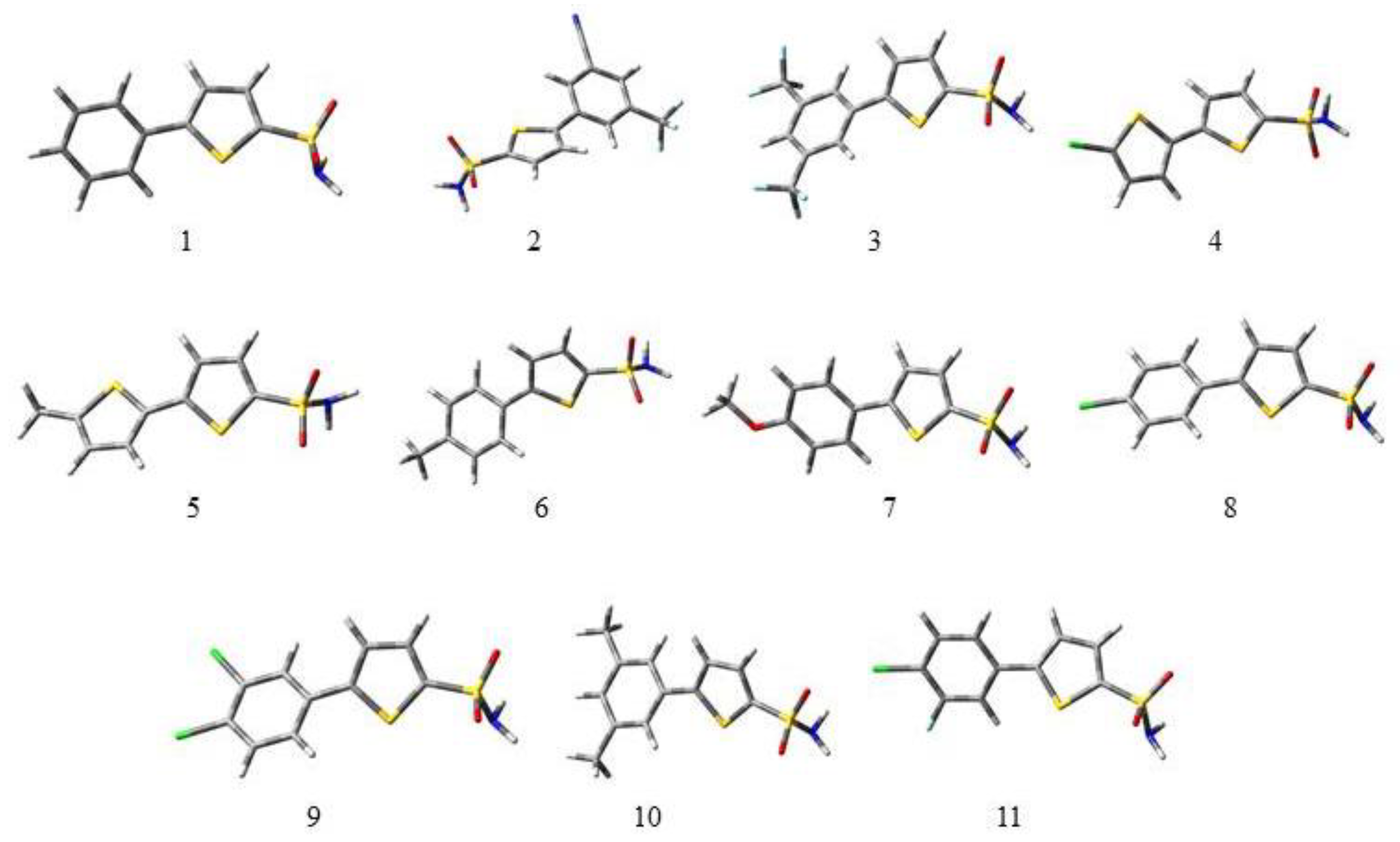
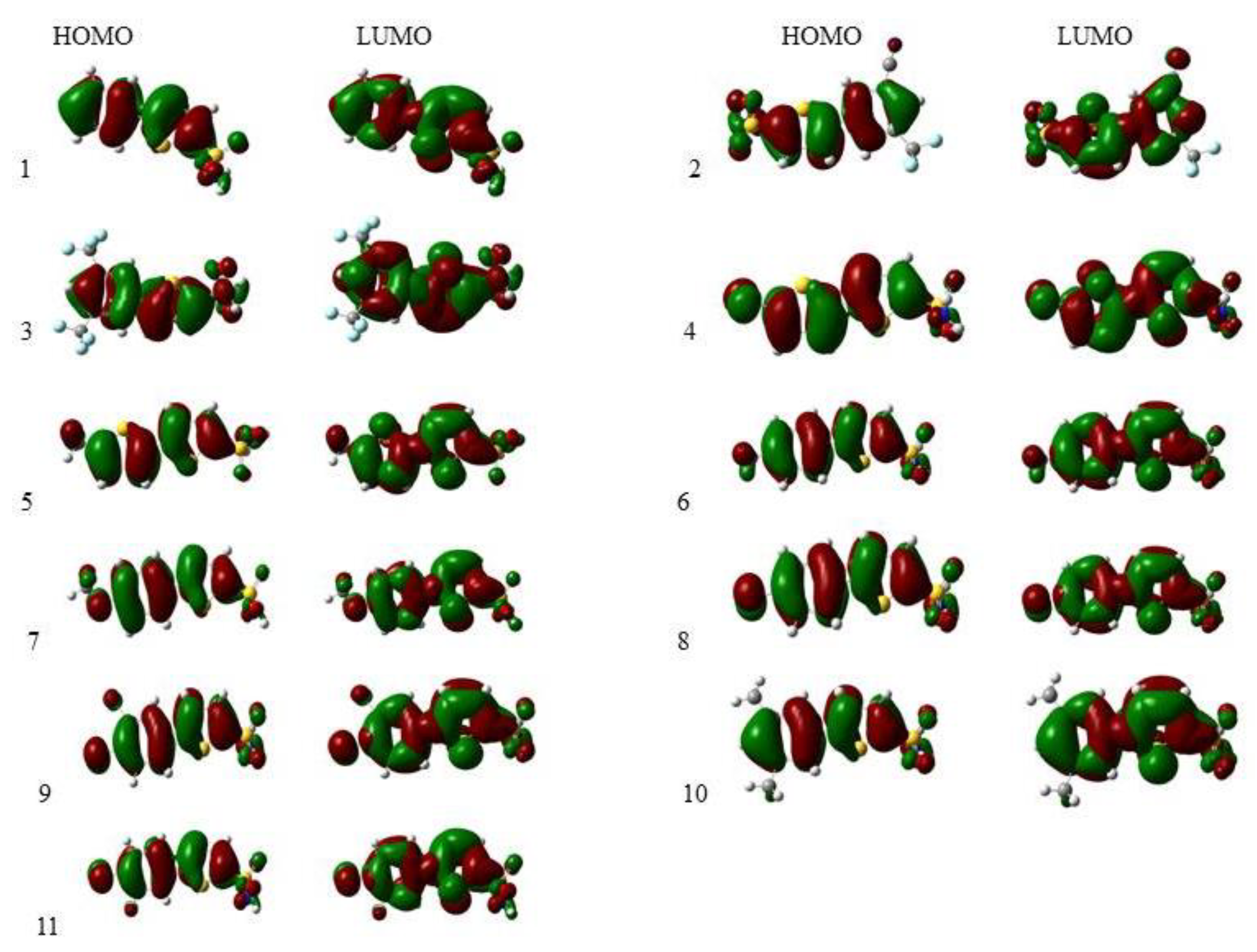
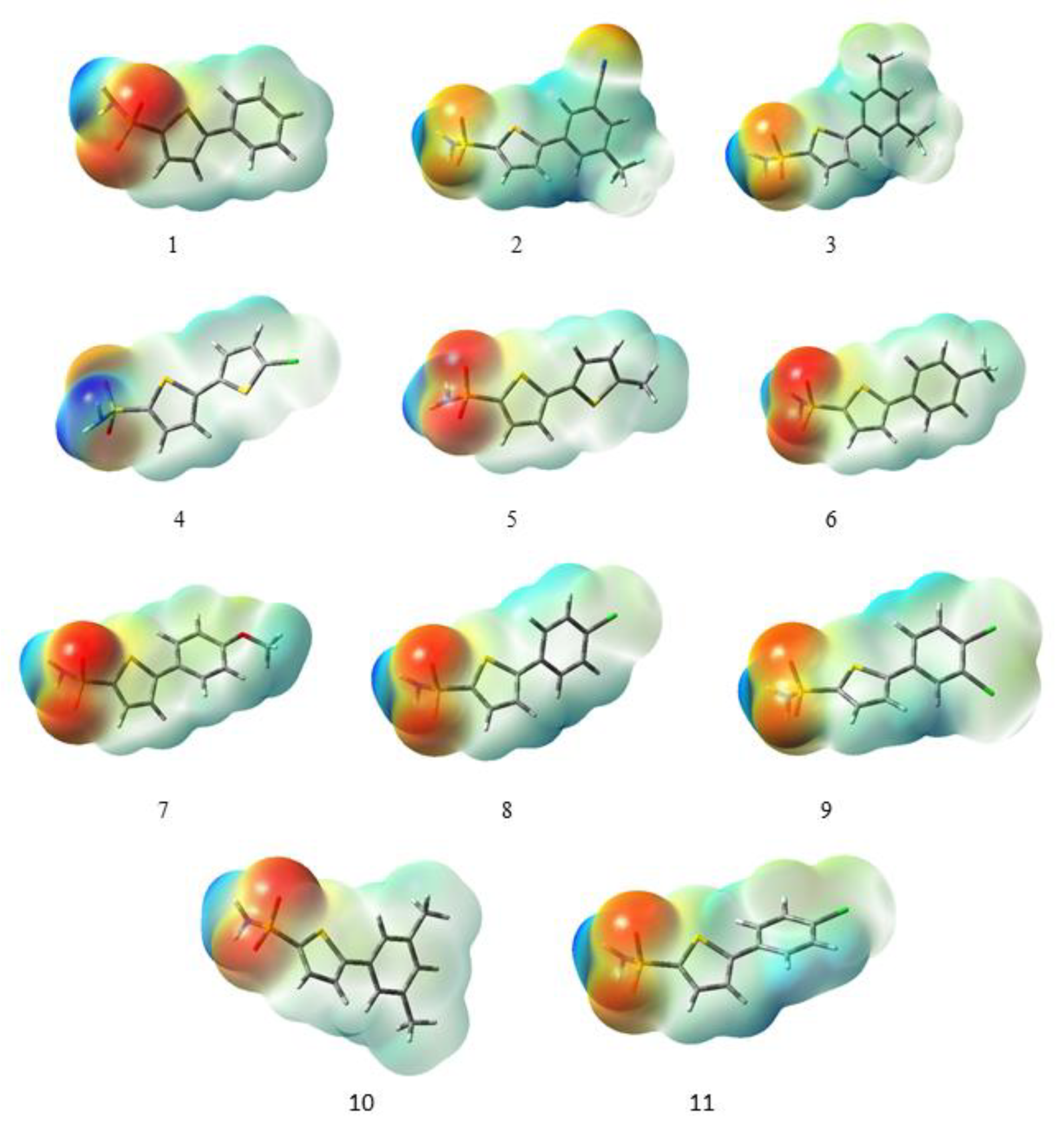

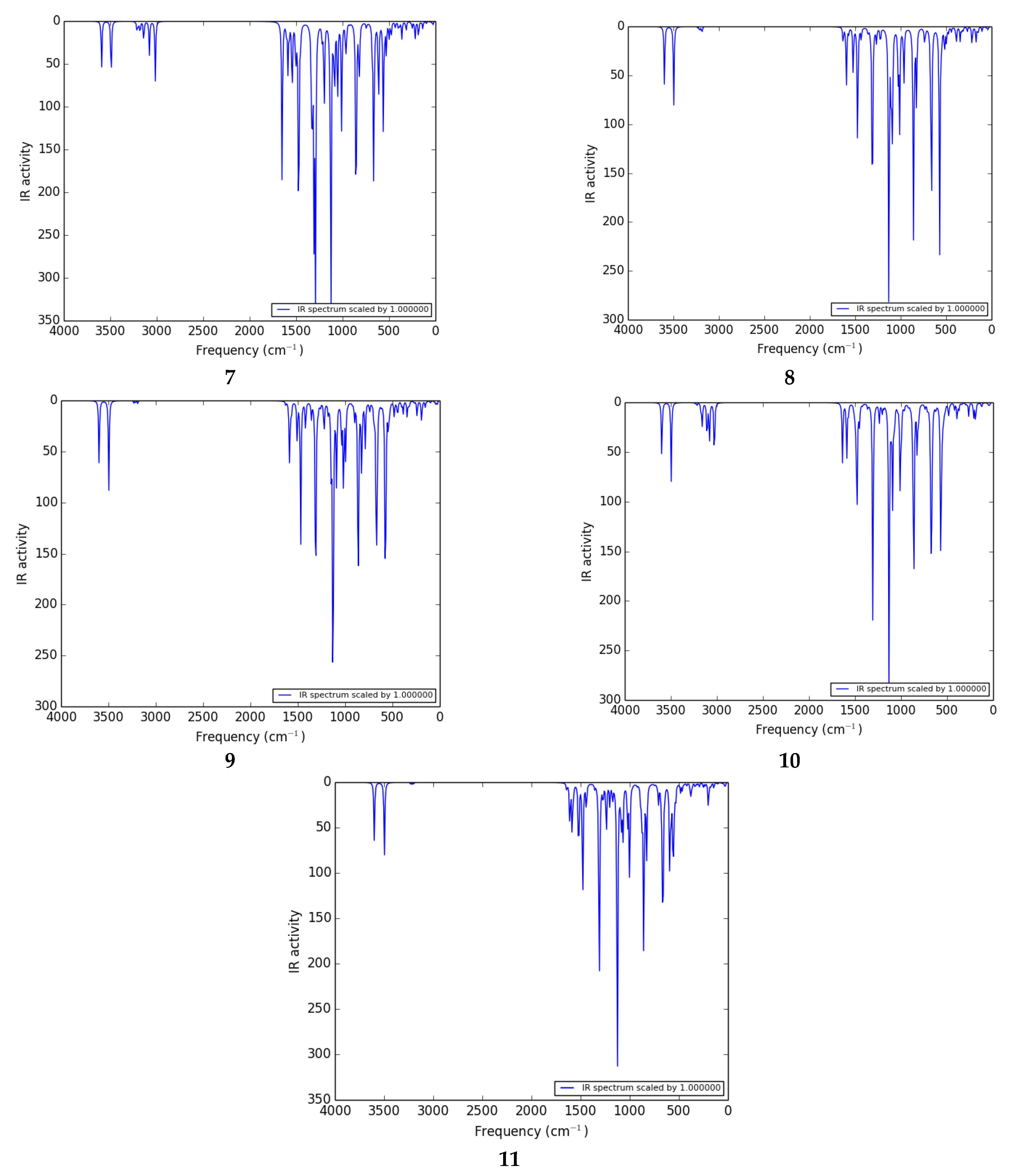
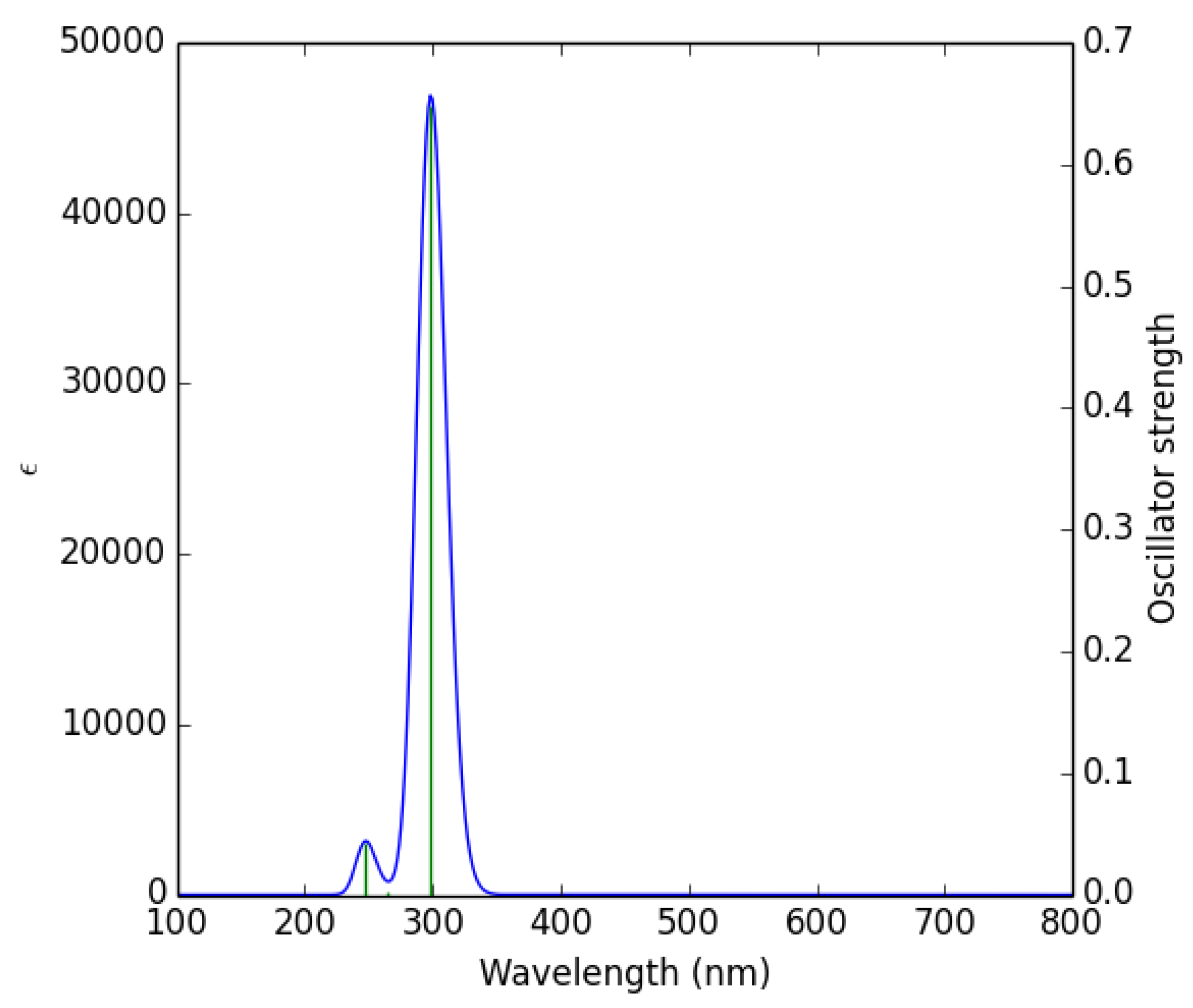
| Bond Lengths (Å) | |||||||||
|---|---|---|---|---|---|---|---|---|---|
| S1–C2 | C2–S | S=O | S–NH2 | C5–S1 | C3’–CN | C4’–Cl | C5’–CF3 | C5’–Cl | |
| 1 | 1.73 | 1.76 | 1.46 | 1.68 | 1.74 | – | – | – | – |
| 2 | 1.73 | 1.77 | 1.45 | 1.67 | 1.74 | 1.43 | – | 1.50 | – |
| 3 | 1.73 | 1.77 | 1.45 | 1.67 | 1.73 | – | – | 1.50 | – |
| 4 | 1.74 | – | 1.46 | 1.68 | 1.74 | – | – | – | 1.73 |
| 5 | 1.75 | – | 1.46 | 1.68 | 1.74 | – | – | – | – |
| 6 | 1.73 | 1.76 | 1.46 | 1.68 | 1.75 | – | – | – | – |
| 7 | 1.73 | 1.76 | 1.46 | 1.68 | 1.75 | – | – | – | – |
| 8 | 1.73 | 1.76 | 1.45 | 1.67 | 1.74 | – | 1.76 | – | – |
| 9 | 1.73 | 1.76 | 1.45 | 1.67 | 1.74 | – | 1.74 | – | – |
| 10 | 1.73 | 1.76 | 1.46 | 1.68 | 1.74 | – | – | – | – |
| 11 | 1.73 | 1.76 | 1.46 | 1.67 | 1.74 | – | 1.76 | – | – |
| Bond Angles (°) | |||||||
|---|---|---|---|---|---|---|---|
| S1–C2–C3 | S1–C2–S | C2–S=O | C2–S– NH2 | O=S–NH2 | C4– C5–S1 | O=S=O | |
| 1 | 112.27 | 122.58 | 106.44 | 102.06 | 111.26 | 110.80 | 120.60 |
| 2 | 112.44 | 122.53 | 109.53 | 101.85 | 105.36 | 111.06 | 120.84 |
| 3 | 112.44 | 122.53 | 109.53 | 101.85 | 105.36 | 111.07 | 121.05 |
| 4 | 111.04 | – | – | – | 110.90 | 112.45 | 121.18 |
| 5 | 110.84 | – | – | – | 110.74 | 112.34 | 121.12 |
| 6 | 112.22 | 122.68 | 109.95 | 102.03 | 105.04 | 110.74 | 120.46 |
| 7 | 112.17 | 122.58 | 109.98 | 101.96 | 105.06 | 110.63 | 120.46 |
| 8 | 112.28 | 122.63 | 109.73 | 102.06 | 105.16 | 110.86 | 120.62 |
| 9 | 112.37 | 122.70 | 109.84 | 101.77 | 105.24 | 110.92 | 120.52 |
| 10 | 112.22 | 122.85 | 110.29 | 101.29 | 105.04 | 110.75 | 120.52 |
| 11 | 112.34 | 122.60 | 109.93 | 101.74 | 105.17 | 110.95 | 120.44 |
| Dihedral Angle (°) | ||||
|---|---|---|---|---|
| 1 | S1–C5–C1’–C2’ | 33.37 | C4–C5–C1’–C2’ | −147.56 |
| 2 | S1–C5–C1’–C2’ | 32.01 | C4–C5–C1’–C2’ | −148.83 |
| 3 | S1–C5–C1’–C2’ | 34.19 | C4–C5–C1’–C2’ | −145.73 |
| 4 | S1–C2–C2’–C3’ | 31.55 | S1–C2–C2’–S1’ | −147.72 |
| 5 | S1–C2–C2’–C3’ | 24.44 | S1–C2–C2’–S1’ | −155.45 |
| 6 | S1–C5–C1’–C2’ | 32.38 | C4–C5–C1’–C2’ | −148.10 |
| 7 | S1–C5–C1’–C2’ | 30.88 | C4–C5–C1’–C2’ | −150.09 |
| 8 | S1–C5–C1’–C2’ | 32.73 | C4–C5–C1’–C2’ | −147.65 |
| 9 | S1–C5–C1’–C2’ | 30.86 | C4–C5–C1’–C2’ | −149.76 |
| 10 | S1–C5–C1’–C2’ | 33.07 | C4–C5–C1’–C2’ | −148.02 |
| 11 | S1–C5–C1’–C2’ | 32.85 | C4–C5–C1’–C2’ | −148.06 |
| Compound | EHOMO | ELUMO | ∆E | Hyperpolarizability (βo) |
|---|---|---|---|---|
| 1 | −6.45 | −1.84 | 4.61 | 641 |
| 2 | −6.99 | −2.42 | 4.57 | 754 |
| 3 | −6.92 | −2.27 | 4.64 | 443 |
| 4 | −6.29 | −2.14 | 4.15 | 2012 |
| 5 | −5.98 | −1.95 | 4.03 | 2089 |
| 6 | −6.28 | −1.77 | 4.50 | 1391 |
| 7 | −5.97 | −2.52 | 3.44 | 3357 |
| 8 | −6.50 | −1.99 | 4.51 | 1380 |
| 9 | −6.64 | −2.16 | 4.48 | 1077 |
| 10 | −6.32 | −1.77 | 4.55 | 1192 |
| 11 | −6.62 | −2.11 | 4.50 | 1240 |
| Bond/Group | Frequency Range (cm−1) | Vibrational Mode | Compounds |
|---|---|---|---|
| H–N–H (amine) | 3590–3610 | Deformation (out of plane) | 6,7,8,9,10,11 |
| H–N–H (amine) | 3602 | Scissoring | Only 3 |
| H–N–H (amine) | 3590–3600 | Antisymmetric stretching | 1,4,5 |
| H–N–H (amine) | 3597 | Wagging | Only 2 |
| H–N–H (amine) | 3490–3500 | Symmetric stretching | 1,4,5 |
| H–N–H (amine) | 3490–3500 | Deformation (out of plane) | 3,6,7,8,9,10,11 |
| H–N–H (amine) | 3494 | Twisting | Only 2 |
| C–H (thiophene) | 3210–3235 | Deformation | 2,3,6,7,8,9,10,11 |
| C–H (phenyl) | 3150–3210 | Deformation | 2,3,6,7,8,9,10,11 |
| C–H (thiophene) | 3210–3235 | Stretching | 1,4,5 |
| C–H (phenyl) | 3165–3200 | Stretching | Only 1 |
| C–H (methyl) | 3010–3140 | Deformation | 5,6,7,10 |
| Ph–CN | 3246 | Deformation | Only 2 |
| C–C (phenyl) | 1590–1655 | Stretching | Except 4,5 |
| C–C (thiophene) | 1550–1650 | Stretching | All |
| H–N–H (amine) | 1580–1600 | Wagging | 2,6,7,8,9 |
| H–N–H (amine) | 1580–1600 | Scissoring | 1,4,5 |
| H–N–H (amine) | 1580–1600 | Deformation | 3,10,11 |
| C–H (methyl) | 1400–1490 | Deformation | 5,6,7,10 |
| O=S=O (sulfonamide) | 1308 | Antisymmetric stretching | Only 1 |
| O=S=O (sulfonamide) | 1300–1315 | Deformation | Except 1,4,5 |
| C–H (thiophene) | 1220–1265 | Deformation | 1,4,5 |
| C–H (thiophene) | 1215–1265 | Stretching | Except 1,4,5 |
| C–H (phenyl) | 1180–1205 | Deformation | Only 1 |
| C–H (phenyl) | 1120–1210 | Stretching | Except 1,4,5 |
| C–H (thiophene) | 995–1130 | Stretching | Except 1,4,5 |
| C=C (thiophene) | 1004–1020 | Stretching | 3,6,7,8,9,10,11 |
| C–H (phenyl) | 915–975 | Deformation | Except 4,5 |
| C–H (thiophene) | 920–940 | Deformation | All |
| H–N–H (amine) | 850–865 | Antisymmetric stretching | Except 1,4,5 |
| H–N–H (amine) | 850–865 | Wagging | 1,4,5 |
| C–H (phenyl) | 820–850 | Deformation | Except 4,5 |
| C–C (thiophene) | 735–755 | Stretching | Except 1,8 |
| H–N–H (amine) | 655–690 | Antisymmetric stretching | All |
| Phenyl, benzo ring | 40–600 | Complex | All |
| Compound | Excitation Energy (eV) | λ max (nm) | Oscillator Strength (f) |
|---|---|---|---|
| 1 | 4.1523 | 299 | 0.6476 |
| 2 | 4.853 | 256 | 0.0374 |
| 3 | 5.054 | 245 | 0.0481 |
| 4 | 4.835 | 256 | 0.2583 |
| 5 | 4.734 | 262 | 0.2742 |
| 6 | 5.111 | 243 | 0.0384 |
| 7 | 5.105 | 243 | 0.0385 |
| 8 | 5.097 | 243 | 0.0411 |
| 9 | 5.017 | 247 | 0.0150 |
| 10 | 5.112 | 243 | 0.0437 |
| 11 | 5.089 | 244 | 0.0550 |
| Compound | I (eV) | A (eV) | ƞ (eV) | σ(eV) | μ (eV) | ω (eV) |
|---|---|---|---|---|---|---|
| 1 | 6.45 | 1.84 | 2.30 | 0.43 | −4.14 | 3.73 |
| 2 | 6.99 | 2.42 | 2.28 | 0.43 | −4.71 | 4.85 |
| 3 | 6.92 | 2.27 | 2.32 | 0.43 | −4.60 | 4.55 |
| 4 | 6.29 | 2.14 | 2.07 | 0.48 | −4.21 | 4.28 |
| 5 | 5.98 | 1.95 | 2.01 | 0.49 | −3.97 | 3.90 |
| 6 | 6.28 | 1.77 | 2.25 | 0.44 | −4.02 | 3.60 |
| 7 | 5.97 | 2.52 | 1.72 | 0.58 | −4.25 | 5.24 |
| 8 | 6.50 | 1.99 | 2.25 | 0.44 | −4.24 | 4.00 |
| 9 | 6.64 | 2.16 | 2.24 | 0.44 | −4.40 | 4.32 |
| 10 | 6.32 | 1.77 | 2.27 | 0.44 | −4.04 | 3.59 |
| 11 | 6.62 | 2.11 | 2.25 | 0.44 | −4.37 | 4.24 |
Publisher’s Note: MDPI stays neutral with regard to jurisdictional claims in published maps and institutional affiliations. |
© 2021 by the authors. Licensee MDPI, Basel, Switzerland. This article is an open access article distributed under the terms and conditions of the Creative Commons Attribution (CC BY) license (http://creativecommons.org/licenses/by/4.0/).
Share and Cite
Mubarik, A.; Rasool, N.; Hashmi, M.A.; Mansha, A.; Zubair, M.; Shaik, M.R.; Sharaf, M.A.F.; Awwad, E.M.; Abdelgawad, A. Computational Study of Structural, Molecular Orbitals, Optical and Thermodynamic Parameters of Thiophene Sulfonamide Derivatives. Crystals 2021, 11, 211. https://doi.org/10.3390/cryst11020211
Mubarik A, Rasool N, Hashmi MA, Mansha A, Zubair M, Shaik MR, Sharaf MAF, Awwad EM, Abdelgawad A. Computational Study of Structural, Molecular Orbitals, Optical and Thermodynamic Parameters of Thiophene Sulfonamide Derivatives. Crystals. 2021; 11(2):211. https://doi.org/10.3390/cryst11020211
Chicago/Turabian StyleMubarik, Adeel, Nasir Rasool, Muhammad Ali Hashmi, Asim Mansha, Muhammad Zubair, Mohammed Rafi Shaik, Mohammed A.F. Sharaf, Emad Mahrous Awwad, and Abdelatty Abdelgawad. 2021. "Computational Study of Structural, Molecular Orbitals, Optical and Thermodynamic Parameters of Thiophene Sulfonamide Derivatives" Crystals 11, no. 2: 211. https://doi.org/10.3390/cryst11020211
APA StyleMubarik, A., Rasool, N., Hashmi, M. A., Mansha, A., Zubair, M., Shaik, M. R., Sharaf, M. A. F., Awwad, E. M., & Abdelgawad, A. (2021). Computational Study of Structural, Molecular Orbitals, Optical and Thermodynamic Parameters of Thiophene Sulfonamide Derivatives. Crystals, 11(2), 211. https://doi.org/10.3390/cryst11020211









